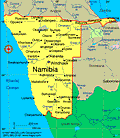Namibia
Facts & Figures

-
President: Hage Geingob (2015)
Prime Minister: Saara Kuugongelwa-Amadhila (2015)
Total area: 318,694 sq mi (825,418 sq km)
Population (2013 est.): 2,182,852 (growth rate: 0.817%); birth rate: 21.11/1000; infant mortality rate: 45.61/1000; life expectancy: 52.17
Capital and largest city (2009 est.): Windhoek, 342,000.
Monetary unit: Namibian dollar
Languages: English 7% (official), Afrikaans is common language of most of the population and of about 60% of the white population, German 32%; indigenous languages: Oshivambo, Herero, Nama: 1%
Ethnicity/race: black 87.5%, white 6%, mixed 6.5%. Note: about 50% of the population belong to the Ovambo tribe and 9% to the Kavangos tribe; other ethnic groups are Herero 7%, Damara 7%, Nama 5%, Caprivian 4%, Bushmen 3%, Baster 2%, Tswana 0.5%
Religions: Christian 80%–90% (Lutheran at least 50%), indigenous beliefs 10%–20%
National Holiday: Independence Day, March 21
Literacy rate: 88.8% (2010 est.)
Economic summary: GDP/PPP (2012 est.): $16.84 billion; per capita $7,800. Real growth rate: 4%. Inflation: 5.8%. Unemployment: 51.2%. Arable land: .99%. Agriculture: millet, sorghum, peanuts, grapes; livestock; fish. Labor force: 818,600; agriculture 16.3%, industry 22.4%, services 61.3% (2008 est.). Industries: meatpacking, fish processing, dairy products; mining (diamonds, lead, zinc, tin, silver, tungsten, uranium, copper). Natural resources: diamonds, copper, uranium, gold, lead, tin, lithium, cadmium, zinc, salt, vanadium, natural gas, hydropower, fish; note: suspected deposits of oil, coal, and iron ore. Exports: $4.657 billion (2012 est.): diamonds, copper, gold, zinc, lead, uranium; cattle, processed fish, karakul skins. Imports: $5.762 billion (2012 est.): foodstuffs; petroleum products and fuel, machinery and equipment, chemicals. Major trading partners: South Africa, U.S. (2006).
Communications: Telephones: main lines in use: 140,000 (2011); mobile cellular: 2.24 million (2011). Broadcast media: 1 private and 1 state-run TV station; satellite and cable TV service is available; state-run radio service broadcasts in multiple languages; about a dozen private radio stations; transmissions of multiple international broadcasters are available (2007). Internet Service Providers (ISPs): 78,280 (2012). Internet users: 127,500,600 (2009).
Transportation: Railways: total: 2,626 km (2008). Highways: total: 64,189 km; paved: 5,477 km; unpaved: 58,712 km (2010). Ports and harbors: Luderitz, Walvis Bay. Airports: 112 (2012).
International disputes: concerns from international experts and local populations over the Okavango Delta ecology in Botswana and human displacement scuttled Namibian plans to construct a hydroelectric dam on Popa Falls along the Angola-Namibia border; managed dispute with South Africa over the location of the boundary in the Orange River; Namibia has supported, and in 2004 Zimbabwe dropped objections to, plans between Botswana and Zambia to build a bridge over the Zambezi River, thereby de facto recognizing a short, but not clearly delimited, Botswana-Zambia boundary in the river.

